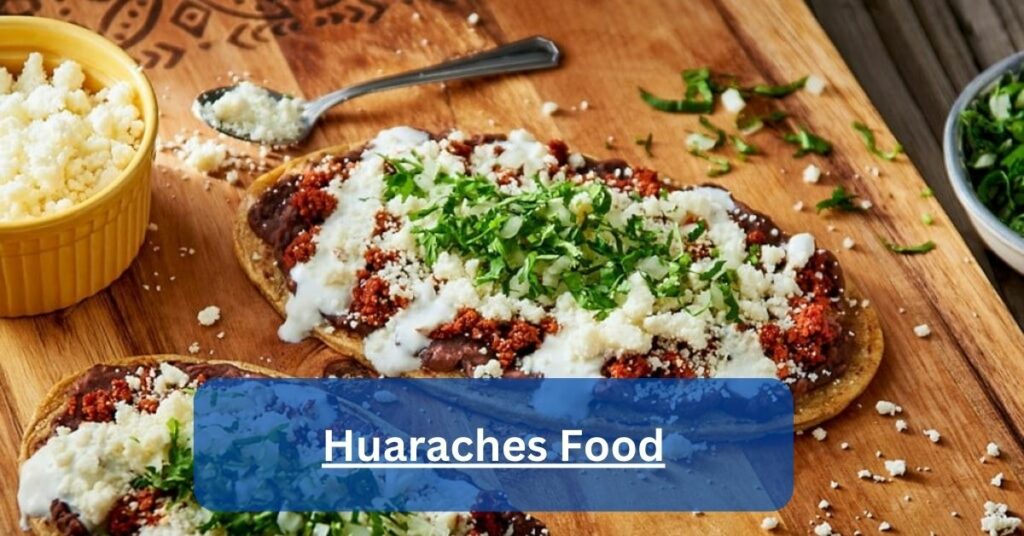Huaraches Food – A Traditional Mexican Delight!

Welcome, food lovers! Today, we’re diving into the wonderful world of huaraches food—a cherished Mexican dish. As someone who loves exploring traditional flavors, I’m excited to take you on this tasty adventure.
Huaraches are a traditional Mexican dish that originated in the central and southern regions of Mexico. They are named after the traditional sandals, also called huaraches, due to their elongated shape resembling the footwear.
Together, we’ll learn all about where huaraches come from, what they’re made of, and the delicious ways they can be enjoyed. Get ready to discover the amazing flavors that make huaraches so special!
What is Huaraches Food?
Huaraches food is a yummy dish that comes from Mexico. It’s called “huaraches” because it looks like the sandals that people in Mexico used to wear a long time ago. flat pancake made from corn flour. That’s the base of huaraches. It’s thick and oval-shaped, like a stretched-out pancake. This base is cooked until it’s a bit crispy on the outside but still soft inside.
On top of this yummy corn pancake, people add all sorts of tasty things. Think of it like making a pizza! You can put on refried beans, which are mashed-up beans cooked with yummy flavors. Then there’s meat, like shredded chicken or beef, for extra protein.
Other toppings might include lettuce, onions, cheese, salsa, and if you like, some avocado or sour cream. It’s like a colorful, flavorful feast on top of that corn pancake base! People enjoy huaraches because they’re not only tasty but also filling, like a full meal in one dish.
How To Make Huaraches – let’s get cooking!
Prepare the Masa Dough: In a big bowl, mix 2 cups of masa harina (corn flour) with a pinch of salt. Slowly add 1 1/4 cups of warm water and mix it all together until it becomes a soft dough. If it’s too dry, add a little more water.
Shape the Huaraches: Divide the dough into small balls, about the size of a golf ball. Take one ball and roll it into a flat oval shape, about 1/4 inch thick. Use your fingers to make a slight dent in the middle, leaving a border around the edges to form the huarache shape.
Cook the Huaraches: Heat a skillet or griddle over medium heat and lightly grease it with oil. Carefully place the shaped huaraches onto the hot surface and cook them for 2-3 minutes on each side, until they’re golden brown and a bit crispy.
Add Toppings: Once the huaraches are cooked, spread a layer of refried beans over each one, covering the whole surface. Then, add your favorite toppings like cooked meat (chicken, beef, etc.), shredded lettuce, chopped onions, crumbled cheese, and salsa.
Garnish and Serve: Finish off your huaraches with optional toppings like sour cream, avocado slices, or fresh cilantro. Serve them warm and enjoy!
Tips:
- Make sure the masa dough is well-kneaded and smooth to ensure a tender and pliable texture.
- Adjust the thickness of the huaraches according to your preference, but keep in mind that thinner huaraches may cook more quickly.
- Be careful not to overcrowd the skillet when cooking the huaraches, as this can make it difficult to flip them.
- Feel free to get creative with the toppings! Experiment with different combinations of meats, cheeses, and salsas to suit your taste preferences.
- With this simple recipe, you can bring the authentic flavors of Mexico into your kitchen and enjoy the deliciousness of homemade huaraches anytime you crave a taste of traditional Mexican cuisine.
Huaraches Vs Sopes – Exploring The Differences!
When it comes to traditional Mexican cuisine, huaraches and sopes are two beloved dishes that often spark debates among food enthusiasts. While they share similarities in appearance and ingredients, there are distinct differences that set them apart. Let’s delve into the nuances of huaraches vs sopes to better understand these delicious culinary creations.
Huaraches:
Appearance: Huaraches are named after the iconic sandals they resemble, characterized by their elongated, oval-shaped masa base. The masa is thicker than a traditional tortilla and cooked on a griddle until it achieves a golden, slightly crispy exterior.
Toppings: Huaraches are typically topped with a variety of savory ingredients, including refried beans, meat (such as shredded chicken or beef), lettuce, onions, cheese, salsa, and optional additions like sour cream or avocado slices.
Texture: The masa base of huaraches provides a sturdy foundation with a rustic texture, offering a satisfying crunch with each bite. The toppings add layers of flavor and contrasting textures, creating a harmonious balance of savory goodness.
Origin: Huaraches originated in the central and southern regions of Mexico, where they were crafted by indigenous communities as a hearty and nourishing meal.
Sopes:
Appearance: Sopes are smaller and thicker than huaraches, with a round masa base that is pinched around the edges to create a raised border. The center of the masa is typically slightly concave, providing a shallow well to hold the toppings.
Toppings: Like huaraches, sopes are topped with a variety of ingredients, including refried beans, meat, lettuce, onions, cheese, salsa, and optional garnishes such as cilantro and radishes. However, due to their smaller size, sopes may have fewer toppings than huaraches.
Texture: Sopes have a thicker and softer texture compared to huaraches, with the masa base retaining a slight chewiness beneath the toppings. The raised edges provide a satisfying contrast in texture, offering a crispy bite along the perimeter.
Origin: Sopes have their origins in central and southern Mexico, much like huaraches, and are enjoyed as a traditional street food and homemade dish.
Key Differences:
Size and Shape: Huaraches are larger and elongated, resembling sandals, while sopes are smaller and round with raised edges.
Thickness and Texture: Huaraches have a thicker masa base with a slightly crispy texture, whereas sopes are thicker and softer, with a chewy center and crispy edges.
Toppings: While both huaraches and sopes feature similar toppings, huaraches may have a greater variety and quantity of ingredients due to their larger size.
Tips And Tricks For Enjoying Huaraches Food – Let’s Take A Look!
Huaraches food offers a delightful culinary experience that can be enhanced with a few simple tips and tricks. Whether you’re a seasoned enthusiast or a newcomer to this traditional Mexican dish, these suggestions will help you make the most of your huaraches dining adventure.
1. Seek Out Authentic Vendors: If you want to eat huaraches, try to find real Mexican restaurants or food stands that make traditional dishes. These places usually use really good ingredients and cook in the old-fashioned way, so you’ll get a tasty and genuine meal.
2. Explore Regional Variations: Embrace the diverse regional influences of huaraches by exploring variations from different parts of Mexico. From the bustling streets of Mexico City to the tranquil villages of Oaxaca, each region offers its own unique twist on this beloved dish. Don’t be afraid to step outside your comfort zone and try something new!
3. Customize Your Toppings: One of the joys of huaraches food is its customizable nature. Experiment with different combinations of toppings to create a personalized culinary masterpiece. Whether you prefer classic ingredients like refried beans and cheese or more adventurous additions like grilled nopales and spicy salsa, the possibilities are endless.
4. Embrace Handheld Dining: While huaraches can be enjoyed with utensils, there’s something uniquely satisfying about eating them with your hands. Embrace the tactile experience of tearing off a piece of masa, loading it with toppings, and savoring each bite without inhibition. Just be sure to have plenty of napkins on hand!
5. Pair with Refreshing Beverages: Complement the robust flavors of huaraches with refreshing beverages that cleanse the palate and enhance the overall dining experience. Traditional Mexican options like agua fresca (fruit-infused water) or horchata (rice milk beverage) provide a cool contrast to the savory elements of the dish. For those seeking a bit of indulgence, a cold cerveza or margarita can also be a delightful accompaniment.
6. Share the Experience: Huaraches are best enjoyed with good company, so why not share the experience with friends or family? Order an assortment of huaraches with various toppings and create a communal dining experience where everyone can sample and savor together. It’s a wonderful way to bond over a shared love of food and culture.
7. Support Local Businesses: Show your appreciation for huaraches food and the culinary artisans who craft it by supporting local businesses that specialize in authentic Mexican cuisine. Whether it’s a family-owned restaurant or a neighborhood food truck, your patronage helps preserve culinary traditions and sustain vibrant communities.
8. Experiment with Homemade Creations: Feeling adventurous? Why not try making your own huaraches at home? While traditional huaraches can be a bit labor-intensive to prepare, there are plenty of recipes and tutorials available online to guide you through the process. Get creative with your toppings and have fun experimenting in the kitchen!
9. Practice Moderation: While huaraches are undeniably delicious, they can also be quite filling due to their hearty nature. Practice moderation by savoring your meal slowly and listening to your body’s hunger cues. If you find yourself getting full, save the rest for later or share with a dining companion.
10. Show Appreciation: Finally, don’t forget to show appreciation for the culinary artisans who bring huaraches food to life. Whether it’s a heartfelt compliment to the chef or a generous tip for your server, a little gesture of gratitude goes a long way in supporting the food industry and fostering a culture of appreciation.
Frequently Asked Questions (FAQs)
1. Are huaraches gluten-free?
Traditional huaraches made with masa are naturally gluten-free, but it’s essential to check for potential cross-contamination if you have gluten sensitivities.
2. Can huaraches be made vegetarian or vegan?
Absolutely! Huaraches can easily be customized to accommodate vegetarian or vegan diets by omitting the meat and dairy toppings and opting for plant-based alternatives such as grilled vegetables, vegan cheese, and avocado.
3. What is the best salsa to serve with huaraches?
The best salsa is a matter of personal preference, but popular choices include salsa roja (red salsa), salsa verde (green salsa), or salsa de molcajete (stone-ground salsa). Experiment with different varieties to find your perfect match!
Conclusion:
Huaraches food isn’t just about eating—it’s a way to honor Mexican cooking traditions and enjoy a mix of delicious flavors. Starting from simple beginnings to becoming loved worldwide, huaraches keep winning over people with their tasty appeal.
So next time you’re craving a taste of Mexico, treat yourself to the savory delights of huaraches food and embark on a culinary adventure like no other.



